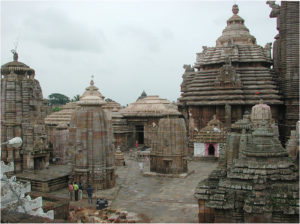Lingaraja Temple is a Hindu temple dedicated to Shiva and is one of the oldest temples in Bhubaneswar, the capital of the East Indian state of Odisha. The temple is the most prominent landmark of Bhubaneswar city and one of the major tourist attractions of the state.
The Lingaraja temple is the largest temple in Bhubaneswar. The central tower of the temple is 180 ft (55 m) tall. The temple represents the quintessence of the Kalinga architectural tradition at Bhubaneswar and it is believed to be built by the kings from the Somavamsi dynasty.The temple is built in the Deula style that has four components namely, vimana (structure containing the sanctum), jagamohana (assembly hall), natamandira(festival hall) and bhoga-mandapa (hall of offerings), each increasing in the height to its predecessor. The temple complex has 50 other shrines and is enclosed by a large compound wall.

Originally the diety of Lingaraja was under the mango tree (Ekamra). So, the Ekamra Kshetra is the another name for Bhubaneswar. Rather than other temples in Bhubaneswar lingaraja temple is very much active in worship practises. People worship the Lord Shiva here as Harihara, a combined form of Vishnu and Shiva.
The temple has images of Vishnu, because of the rising prominence of Jagannath sect emanating from the Ganga rulers built Jagannath Temple in Puri.
The Temple Trust Board and the Archaeological Survey of India (ASI) maintains the Lingaraja temple. The temple has an average of 6,000 visitors per day and receives lakhs of visitors during festivals. Shivaratri festival is the major festival celebrated in the temple and event during 2012 witnessed 200,000 visitors. The temple compound is not open to non-Hindus, but there is a viewing platform beside the wall offering a good view of the main exteriors. This was originally erected for a visit by Lord Curzon when Viceroy.
History:
Lingaraja, literally means the king of Lingam, the iconic form or Shiva. Shiva was originally worshipped as Kirtivasa and later as Harihara and is commonly referred as Tribhuvaneshwara (also called Bhubaneswar), the master of three worlds, namely, heaven, earth and netherworld. His consort is called Bhuvaneshvari.
The temple in its present form dates back to the last decade of the eleventh century. There is evidence that part of the temple was built during the sixth century CE as mentioned in some of the seventh century Sanskrit texts.Fergusson believes that the temple might have been initiated by Lalat Indu Keshari who reigned from 615 to 657 CE. The Assembly hall (jagamohana), sanctum and temple tower were built during the eleventh century, while the Hall of offering (bhoga-mandapa) was built during the twelfth century.
The wife of Salini built natamandira between 1099 and 1104 CE in the mean while Lingaraja temple was constructed completely. Historians believe that jagannath (form of Vishnu) sect had grown up in the regions evidenced by worshipping Vishnu and Shiva at the temple.

The kings of Ganga dynasty were followers of Vaishnavism and built Jagannath Temple at Puri.
As per some accounts, the temple is believed to have been built by the Somavanshi king Yayati I (1025-1040), during the 11th century CE. Jajati Keshari shifted his capital from Jajpur to Bhubaneswar which was referred to as Ekamra Kshetra in the Brahma Purana, an ancient scripture. One of the Somavamsi queens donated a village to the temple and the Brahmins attached to the temple received generous grants. An inscription from the Saka year 1094 (1172 CE) indicates gifts of gold coins to the temple by Rajaraja II.Another inscription of Narasimha I from the 11th century indicates offer of beetel leaves as tambula to the presiding deity.Other stone inscriptions in the temple indicate royal grants from Chodaganga to the nearby village people.
Festival and worship practises:
As per Hindu legend, an underground river originating from the Lingaraja temple fills the Bindusagar Tank (meaning ocean drop) and the water is believed to heal physical and spiritual illness. The water from the tank is thus treated sacred and pilgrims take a holy dip during festive occasions. The central deity of the temple, Lingaraja, is worshipped both as Shiva and Vishnu. The harmony between the two sects of Hinduism, Shaivism and Vaishanvism, is seen in this temple where the deity is worshipped as Harihara, a combined form of Vishnu and Shiva.
Rukuna Ratha yatra is an annual Ratha yatra of Lingaraja.

Thousands of devotees visit the temple during the main festival Shivaratri which is celebrated annually in the month Phalgun. Apart from a full day of fasting, bel leaves are offered to Lingaraja on this auspicious day. The main celebrations take place at night when devotees pray all night long. Usually devotees leave their fast after lighting up the Mahadipa on the spire of the temple.
This festival commemorates Lingaraja having slayed a demon.Every year in the month of Shravana bol bom pilgrims go to the temple by walk and also they carry water of the river Mahanadi.Sunian day is observed from royal times in the month of Bhandra, a day when temple servants, peasants and other holders of temple lands offer loyalty and tribute to Lingaraja.
Candan Yatra (Sandalwood ceremony) is a 22-day festival celebrated in the temple when servants of the temple disport themselves in a specially made barge in Bindusagar tank. The deities and servants of the temples are anointed with sandalwood paste to protect from heat. The people who associates with the temple will arrange dances, communal feasts and merrymaking.
Every year the chariot festival (Ratha-Yatra) of Lingaraja is celebrated on Ashokashtami. The deity is taken in a chariot to Rameshwar Deula temple. Thousands of devotees follow and pull brightly decorated chariots containing the idols of Lingaraja and his sister Rukmani.
The temple management will not allow the non hindus inside the temple but they can view from the viewing platform which is located to the right side of the main entrance of the temple.Sanctity of the temple is maitained by disallowing dogs, unbathed visitors, mensturating women and families that encountered birth or death in the preceding 12 days.
In case of a foreign trespass, the temple follows a purification ritual and dumping of prasad (food offering) in a well.

